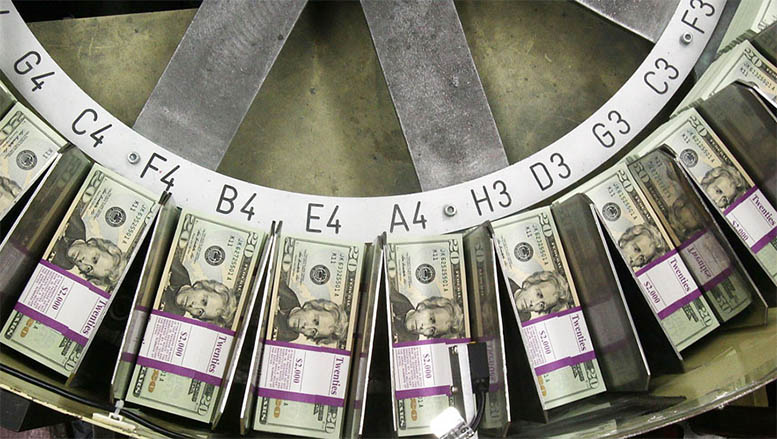The world over people are told that central banks pursue “price stability” by making sure that consumer goods prices do not rise by more than 2 percent per annum. This is, of course, a big sham. If the prices of goods rise over time, it does not take that much to understand that prices do not remain stable. And if the prices of goods increase over time, it necessarily means that the purchasing power of the money unit declines.
As money loses its purchasing power, income and wealth are stealthily redistributed. Some individuals and groups of people are enriched at the expense of others. Savers and workers are swindled out of their deserved income and retirement benefits, while those who own goods that rise in value or who borrow money typically reap a windfall profit. Clearly, the banking industry is a major beneficiary of monetary debasement.
“Inflation” Is a Rise in the Quantity of Money
Central banks are the very source of the phenomenon that all prices of goods tend to rise over time. They hold the money production monopoly and increase — in close cooperation with commercial banks — the outstanding quantity of money through credit expansion, an increase in the supply of credit that is not backed by real savings. It goes without saying that it is rather profitable to be active in the money-production business.
The increase in the quantity of money results, and necessarily so, in higher prices compared to a situation in which the quantity of money has not been increased. This is no arbitrary assertion but stems from logical reasoning: a rise in people’s money holding lowers the marginal utility of the additional money unit, meaning that the marginal utility of other goods that can be exchanged against money rises.
Consider the case in which the quantity of money in the hands of market agents rises. People will then exchange money balances (which have, from the viewpoint of the money holder, lost in marginal utility) against other vendible items (which have gone up in marginal utility). As people exchange money units against other goods, money prices go up (compared to a situation in which the quantity of money has not been increased).
The Mainstream Explanation and Its Problems
Of course, in real life additional factors (such as, for instance, demand changes, market introduction of new products, etc.) interfere with the link between the increase in the quantity of money and the rising prices of goods. This, however, by no means refutes the economic insight that a rise in the quantity of money in the economy leads to goods prices that will be higher than if the quantity of money not been increased.
The increase in the quantity of money is what deserves to be called inflation; rising prices are just a possible symptom of an increase in the quantity of money. However, mainstream economists typically define inflation as rising consumer goods prices. This, however, is problematic for at least two reasons. First, by equating inflation with rising prices, the real reason for higher prices, namely the rise in the quantity of money, is obscured.
This, in turn, gives rise to arbitrary explanations of why goods prices may go up: sheikhs who force up oil prices, unions that cause wages to rise, an overall buoyant economy that creates shortages in production factors, and so forth. All these pseudo-explanations deflect from the real culprit — the central bank, in cooperation with commercial banks, which issues new money, so that people no longer understand who, in fact, harms them.
Asset Price Inflation
Second, changes in consumer goods prices do not tell us the entire story, for they do not take into account asset prices such as, for instance, stock prices, housing prices, and land prices. However, the newly injected money can be expected to not only push up consumer goods prices, but also drive up asset prices. And like rising consumer prices, rising asset prices diminish the purchasing power of money.
In other words: asset price inflation destroys the purchasing power of money in the same way that price inflation of consumer goods does. Take, for instance, stock market prices. If prices rise from, say, $100 to $200, the purchasing power of the money unit would drop by 50 percent. The owner of the stock becomes richer, while the holder of dollars become poorer. In fact, this is precisely what has been happening in the last decades.
For illustrative purposes, let us take a look at the chart above. It shows the development of the US quantity of money, nominal GDP, and stock prices from 1996 to autumn 2019. In the period under review, the US nominal GDP increased by 4.3 percent per annum on average. The quantity of money rose by 6.1 percent, while stock prices expanded by 8.1 percent. To the attentive observer, these numbers contain an important message.
The increase in the money supply does not only raise prices of consumer goods, but also tends to raise all prices. For instance, in the period under review, on average, the real GDP in the US rose around 1.9 percent per year while prices of goods and services that are included in US GDP went up by 2.4 percent. The remaining “excess money” obviously pushed up stock prices and other asset prices such as for instance, housing prices.
Don’t Put Your Trust in Today’s (Fiat) Money
The lessons to learn are these: always think of inflation as a rise in the quantity of money. Be aware that central banks and commercial banks provide a kind of money that does not keep its purchasing power — that most people suffer losses when holding it for the purpose of storing wealth. Better not to put your trust in today’s money and keep your transaction balances as small as possible. Don’t be taken in by the inflation sham.
The insights outlined above should encourage all of us to join the call for better, sound money — money that lives up to the highest economic and ethical standards. This can be achieved by simply creating a free market in money, where people are free to choose the kind of money they would like to use, and where entrepreneurial spirits are free to make their fellow people sound-money offers.
A free market in money — which would be tantamount to putting an end to central banks’ money production monopolies — is actually easy to establish. Just strip the official currency of its privileged “legal tender” status and remove all capital gain and sales taxes on all media that stand an excellent chance to compete for becoming currency — most notably gold and silver but potentially also crypto units.
A free market in money will work wonders. Many of the evils that haunt our world today — be they chronic price inflation, financial and economic crises, boom-and-bust cycles, and even over-funded governments and aggressive wars, would be greatly reduced. One of the biggest challenges of our time is to reform our money. The solution is to open up the market in money.
This article was sourced from Mises.org
 By
By 
